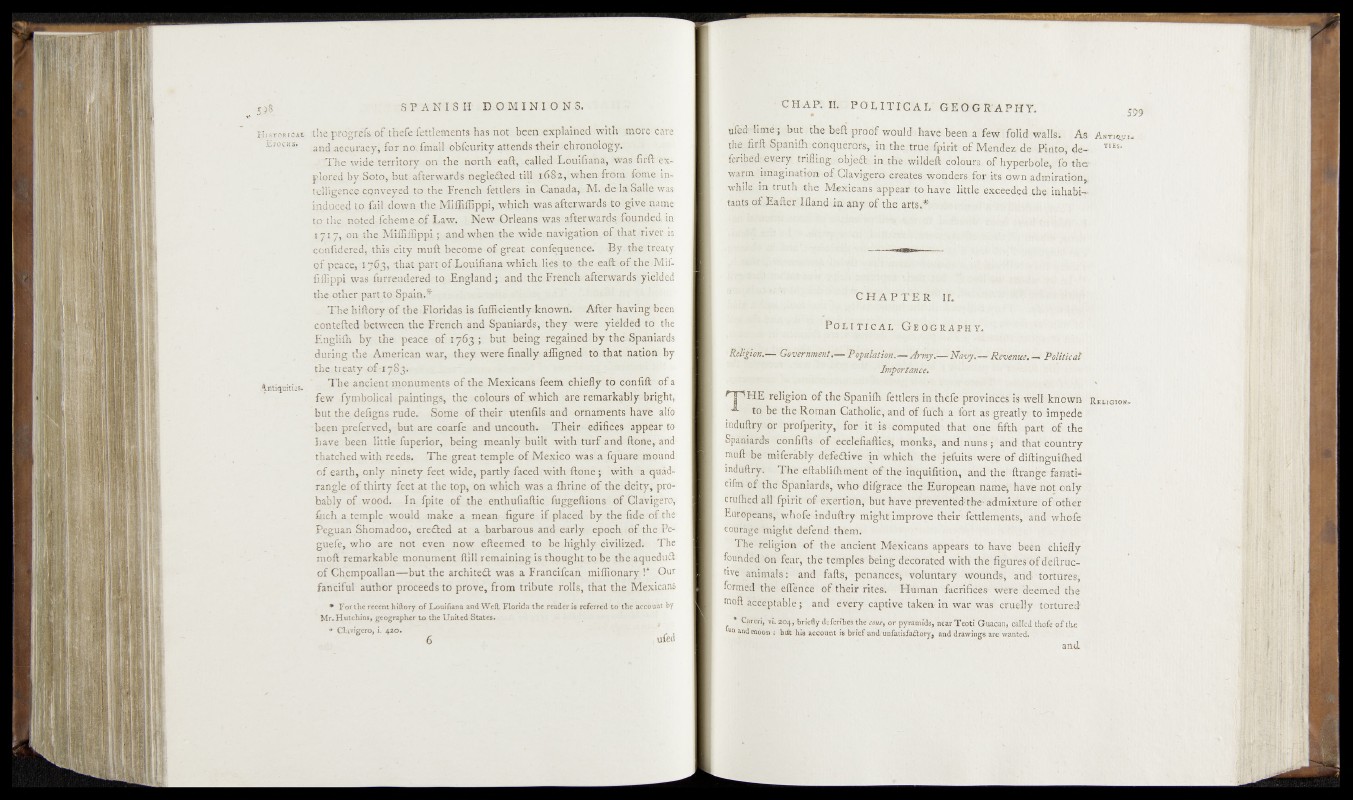
•the progrifs of tbefe feulements .-has not been explained with more care
and accuracy, for no.fmall obfcurity attends their chronology. - •
'The wide territory on the north eaft, called Louifiana, was firft explored
by Soto, but afterwards negledted till 1682, when from fome intelligence
conveyed to the French fettlers in Canada, M. de la Salle was
induced to fail down the Miffiffippi, which was afterwards to give, name
tp the noted- feheme of Law. New Orleans was afterwards founded in
17 17, on the Miffiffippi ; and-when the wide navigation of that river, is
confidered, this city muft become of great -çonfequénce. . -By the treaty
of peace, 1763, that part of Louifiana which lies to 1 «. of the.Miffiffippi
was furreodered to England ; and the French afterwards ^el^ed
the other part tp Spàltli*
,, The hiftpry <q£ the Floridas is After-having-been
contefted between the French and Spaniards, theyTvVere' yielded to <Bhe
F.nglilh by the peace of 1763 buf hefcg[*^bmed:by utóSplhhttds
during.the American war, they were finally- affigned tó that nation by
the treaty of-1783.
‘ The ancient monuments ofi the Mexicans feem chiefly to confifL of a
few fyinbolical paintings the colours of. which are remarkably feight,
but the defigns rude. Some of their utenfils-and omat&çfifs hafl .pfc)
been preferred, but are çoarfe and uncouth. Their' edifices 'âppéafcto
have been little fnperior, being .meanly huilf withïl^Jwnd and
thatched with reeds. The great temple of Mexico wasla fcfua-te moiind
of earth, only ninety feet wide, partly ,facæd withfftô»ê|: 'ifeithid^rtd'-
rangl.e of thirty feet at the top, on which was a fhrine of the deity, pro-
hably of wood. In fpite of the enthufiaftic fuggeftions of Clavigerö,
fitch a temple would make a mean figure if placed by the fide of the
Peguan Shomadoo, erected at a barbarous and early epoch of the Pe-
guefe, who are not even now efteemed to be highly civilized. The
moil remarkable monument ftill remaining is thought to be the aquedudt
of Chempoallan-—but the architect was a Francifcan miffionary ^Wur
fanciful authbr proceeds to prove, from tribute rolls, that the Mexicans
* For the recent hiftory of Louifiana and Weft Florida the reader is referred to the account by
Mr. Hutchins, geographer to the United States.
* Clavigerö, i. 420. 6 ufed
ufetHitpe*; hut-theThéfb‘proof woulduhava®,lee®|;| fevélfolid walls; As- Antiqv«-
tip firft Spaniffi- conquerors, in the true fpirit of Mendez de Pinto, de- * TI&5‘
(cfi'KdkCyery t r iâ i^ ^ y ^ in the wfideft: col^u5^'eÿ.hyp^^l^,'thet
warm- foryits^yn'^miratipn^
while in t^uth .the ^xjcan^p^ea^to/Weidhtle exeee^Lufe; inhabi-f.
tants of Eafter Ifland in any of the artai^éjrâ
ir.: '
/ ' G eiJ^raph r.
ReligiotiV— G^tkYnment^^Pop&hthn'.-^ Army.— Navy'.— Revenue, —t Paltiica?
y Importance.- I
'P H E rehgion of tho'Spaniffi.fiêttlers^ifi'îhefe provrficësHàwelIknown rbli^ k^
tp, be the Roman Catholic, dïid Of. fuch a 'ï®ët as .‘greaMy-1 tbfifi^edVfv’
in|uftry or profperity,1 for it" is computed that?, erioffifth part- of the
Spaniards “SMnftfts* 'bfi 'eeclefia-fticsj monks, and ndW‘;Aand that’ cou’ntry
i^ft- be miferably defedtive in which the jefuits’fwer^'ofi diftinguifhed'
influftry, The eftabliffiment of thednquifition, and thel’ftrabge’ fefTatr-i
cifûi of thé Spaniards, who difgrace thé European name*, havé not onl^-v
cfftfedM' fpirit of e&ertion, but have prevented1 the: ad mixturelb’ftother
Europeans, whofe India ft ry’ might’ i mp'royê tKéir* 'fëUtéïffèiite;' ÿârid ' whöfè
courage might defend them.
Thé- teli'gion of the ancient Mexicans appears tó have bbèti Chiefly"
foïmcîèd bn fear, the temples being decorated with the 'figóre^bföèftrüc-
bvé ’anitnals : and fiafte, penances'; ‘ voluntary wounds, afid*'tor-flares;
formed the eflence of their rites'. Human facrifiee&'^Weï^’Uteömed'the
oioft.tdceptable and every captive taken in war wah' cSu^liy •'toffcffited
* Careri, vi. 204., briefly deferibes the cons, o r pyramids, near Teoti Guacan, called thofe of the
“»and moon : kvft his account is brief and. unfausfadtory, and drawings are wanted.
and.